| 16 Jan 2023 | 08:00 - 18:00 | Online & Room SG1, Alison Richard Building, 7 West Road, Cambridge | |
- Description
- Programme
- Call for papers
- Abstracts
- Convenors
Description
Convenors
- Lavinia Maddaluno (Ca’ Foscari, Venice)
- Giacomo Savani (St Andrews University)
- Davide Martino (University of Cambridge)
Summary
This workshop aims to bring together scholars from early modern social, cultural, and environmental history, as well as intellectual historians and historians of science and material culture, to talk about water across different settings and geopolitical contexts in Europe between 1450 and 1700. The focus will be on early modern communities, their social and political institutions, and how they interacted with water.
In particular, we are interested in the fluid and ever-evolving system of water-related infrastructures put in place and constantly negotiated and redefined by states, institutions, and various actors, at urban, peri-urban and rural levels. How did these infrastructures play out in conflicts between local and central authorities in the early modern period? To what extent did this process bear political dimensions? How did local communities across different geographical contexts contribute to reconfiguring these dynamics? For instance, we intend to explore how attempts to improve navigable channels to facilitate commercial exchanges often coexisted with conservative forces that resisted innovation. Access to drinking water is another suitable example: who, if anyone, controlled it? How was it distributed, and did it mirror social differences and hierarchies? Whether natural or artificial, waterways could also serve for the disposal of waste. How was this activity regulated, and by whom? We are also interested in the negotiation between landlords and legislators about the legal status of thermal waters (could they be privately owned, or should they be considered a public asset?) and the benefits and risks of public baths in towns. The overarching scope of the event is to reconstruct early modern ways of organising societies around water, establishing how these reflected models of sovereignty and forms of political participation to the res publica.
By offering a lively and challenging setting for international scholars at all stages of their careers to share ideas and present work in progress, the goal of the event is to generate innovative, interdisciplinary research on the richness and diversity of water history. Considering the current environmental crisis and water inequality, the focus on water as a disputed asset is particularly topical and will hopefully raise broader questions relevant to the present.
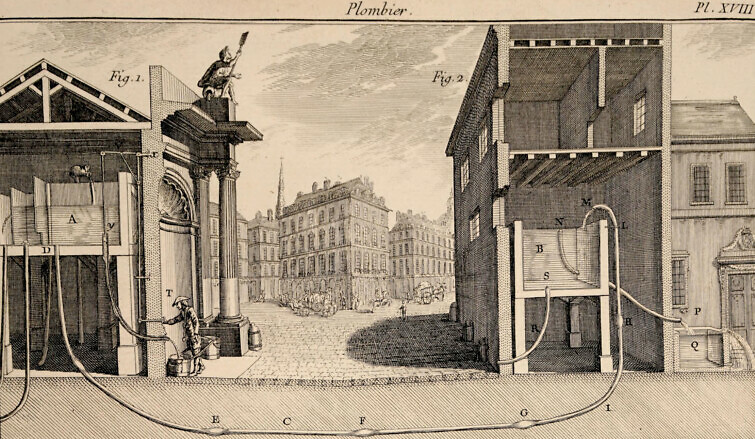
‘Cisterns and lead pipes network’ from Claude Mathieu Delagardette, L’art du plombier et du fontainier (Paris, 1773). Wikimedia Commons (Wellcome Library)
Supported by:

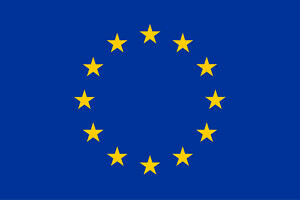
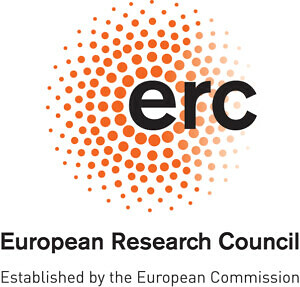
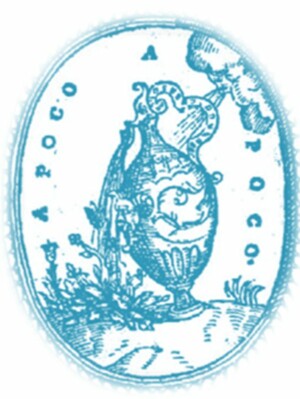

In cooperation with the team of the H2020 ERC “Water-Cultures” project (grant agreement No 833834)
If you have specific accessibility needs for this event please get in touch. We will do our best to accommodate any requests.
Programme
| 8:00 - 9:00 | Registration |
| 9:00 - 9:15 | Welcome |
| 9:15 - 10:15 | Panel 1: Water uses and users
Chair: David Gentilcore (Ca’ Foscari University of Venice) |
| 10:15 -10:45 | Break |
| 10:45 - 12:00 | Panel 2: Mediterranean cities
Chair: Melissa Calaresu (University of Cambridge) |
| 12:00 - 13:00 | Lunch |
| 13:00 - 14:00 | Roundtable
Chair: TBC |
| 14:00 - 14:15 | Break |
| 14:15 - 15:00 | Panel 3: Florence I virtual
Chair: Deborah Howard (University of Cambridge) |
| 15:30 - 16:00 | Break |
| 16:00 - 16:45 | Special session: projects’ presentation
|
| 16:45 - 17:00 | Break |
| 17:00 - 18:00 | Panel 4: River management
Chair: TBC |
| 18:00 | Concluding remarks |
Call for papers
This workshop aims to bring together scholars from early modern social, cultural, and environmental history, as well as intellectual historians and historians of science and material culture, to talk about water across different settings and geopolitical contexts in Europe between 1450 and 1700. The focus will be on early modern communities, their social and political institutions, and how they interacted with water.
We are particularly interested in the fluid and ever-evolving system of water-related infrastructures put in place and constantly negotiated and redefined by states, institutions, and various actors, at urban, peri-urban and rural levels. For instance, we intend to explore how attempts to improve navigable channels to facilitate commercial exchanges often coexisted with conservative forces that resisted innovation. Access to drinking water is another suitable example to examine questions of resource management and control, and the way water distribution mirrored social differences and hierarchies. We are also interested in the negotiation between landlords and legislators about the legal status of thermal waters and the benefits and risks of public baths in towns. Overall, the general scope of the event is to reconstruct early modern ways of organising societies around water, establishing how these reflected models of sovereignty and forms of political participation to the res publica.
We are interested in papers that address questions such as:
- Who, if anyone, controlled water resources?
- How was water distributed, and did it mirror social differences and hierarchies?
- How did water infrastructures emerge from and were affected by conflicts between local and central authorities in the early modern period?
- To what extent did this process bear political dimensions?
- How did local communities across different geographical contexts contribute to reconfiguring these dynamics?
- Whether natural or artificial, waterways could also serve for the disposal of waste. How was this activity regulated, and by whom?
- Which was the status of public baths and spas? Could they be privately owned, or should they be considered a public asset?
By offering a lively and challenging setting for international scholars at all stages of their careers to share ideas and present work in progress, the goal of the event is to generate innovative, interdisciplinary research on the richness and diversity of water history. Considering the current environmental crisis and water inequality, the focus on water as a disputed asset is particularly topical and will hopefully raise broader questions relevant to the present.
We welcome proposals for 20-minute papers, which will be followed by a Q&A.
Please, submit an abstract of not more than 250 words by 15 July 2022 to the organisers: Lavinia Maddaluno (laviniamaddaluno@gmail.com), Davide Martino (dm641@cam.ac.uk) and Giacomo Savani (giacomo.savani@gmail.com)
Abstracts
Ada Arendt (University of Oslo)
‘Manorial fishponds as a more-than-human assemblage, a contact zone, and a temporality’
In my paper, I would like to examine the relational dynamics of manorial fishponds belonging to the Bishop of Cracow at the Polish-Silesian borderlands at the turn of the 17th and 18th century. Crucial for assuring food security, the fishponds were a laboratory of power relations within the manorial and cliental system, as well as an important factor determining its temporal organisation. Based on almanac annotations of the bishop’s superintendent and manorial administrator, Ludwik Mikołaj Grabiański, and two Polish-language treaties on the management of fishponds (Strumieński 1573; Strojnowski 1609), I would like to reconstruct the more-than-human assemblage of actors caring for, exploiting, and managing the fishponds; reflect on the polyphonic, synchronized and cyclical temporality of this assemblage; and, finally, examine ‘how things hold’ (Gan, Tsing 2018) in this particular rural network, which had to navigate several local crises: social disintegration, political unrest and ongoing deforestation, desertification, water pollution and over-abstraction resulting from the Bishop’s extensive ‘technological patronage’ over the territory. The paper is a work-in-progress for a book I am currently working on, commissioned by the editors of the Routledge ‘Microhistories’ book series, under the working title In the Contact Zone. The Microhistory of Care.
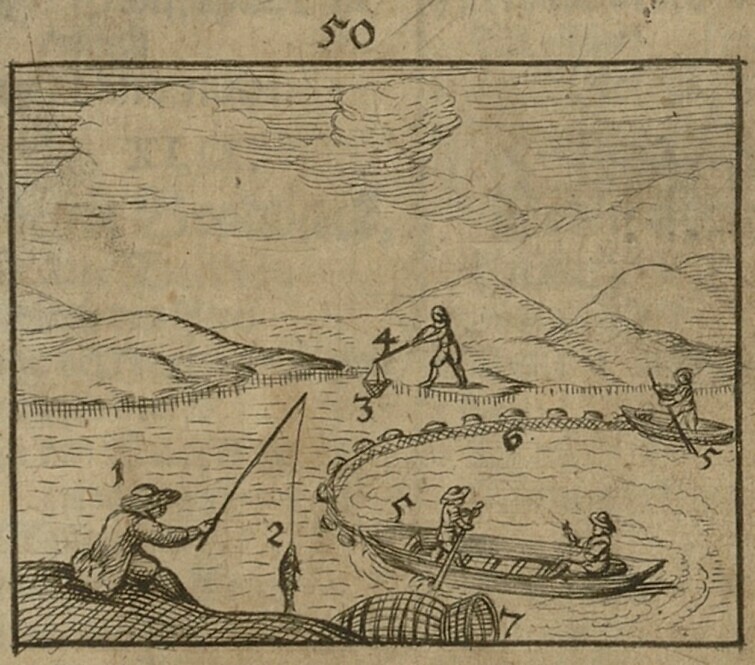
John Amos Comenius, Orbis sensualium pictus…, Kaspar Müller and Christoph Tschorn: Bregae-Breslau 1667, from the collection of the Jagiellonian Library. Public domain.
Francesco Barreca (University of Milan)
‘A shadowy legacy: Vincenzo Viviani and the Ombrone’
Today, Vincenzo Viviani’s approach to hydraulic engineering is recognized as surprisingly innovative, modern, and effective. His framing of the problem of river management within the more general context of environmental management is seen as somewhat an anticipation of a modern tendency that would emerge only in the XIX century, and the relazioni he wrote during his long career as Ingegnere are praised as examples of exactness, excellent economic planning, and careful consideration of pros and cons in engineering. These distinctive features of Viviani’s approach are often linked to his devotion to Galileo and Galilean science. It is assumed that Viviani’s work in engineering is so peculiar precisely because even in engineering he was a loyal, almost sycophantic follower of Galileo. However, while saying that Galileo was a major influence on Viviani would surely be an understatement, it must not be forgotten that, contrary to Torricelli and Castelli, Viviani became an engineer by working on the field, and that the operative duties he was charged with required him to negotiate his supposedly strict Galilean beliefs. This negotiation is apparent from the accommodation of the Ombrone Pistoiese river, a project that, starting from 1644, would end up occupying most of Viviani’s professional career and contributed decisively to shape his peculiar views about hydraulic engineering.
Gaia Bruno (Ca’ Foscari University of Venice)
‘Under and over the ground. The everyday provisioning of water in Early Modern Naples’
In 1583 Bartolomeo Nigro, a nine-year-old Neapolitan boy, described his terrific experience in the Neapolitan underground to a judge. Together with his uncle and a priest, he descended in a water well to find a treasure. There in the dark, he heard the voice of a spirit, who gave him instructions on where to dig. The trial from the Archivio Diocesano di Napoli, in which Bartolomeo’s testimony is included, is an extraordinary key to enter into the world of early modern beliefs regarding the supernatural essence of the underground and its waters; at the same time, the document tells us much more about the everyday relationship between the inhabitants of an early modern Mediterranean city and their access to water.
Starting from the analysis of this trial, my talk aims to show the multiple dimensions that lay behind water wells. Until the diffusion of the running water system in the late XIX century, wells were the principal means to provide the city with drinkable water. On the other hand, they were perceived as a gate to communicate with the afterlife.
Tatiana Carbonell (ETH Zürich)
‘Climate historiographies for a pastoral Rhône Valley: Scientists, engineers, and chroniclers’ visions on Early Modern environmental knowledge’
Melting glaciers, biblical floods, and storm clouds were threats that prompted several technical transformations along the Rhône River. During the nineteenth century, the alpine Rhône Valley was an area of experimentation, where scientists, engineers, and chroniclers regulated nature and territory. This research demonstrates that by establishing working principles based in the dominance of nature under pastoral ideals, they produced proto climate theories in the process. Focusing on the first project for the Rhone Correction started in 1776 in the Swiss Valais, this paper follows the implementation of three infrastructures designed to control climatic events producing knowledge that prompted questions about climate historiography. This epistemological turn contributed to define climate as a changeable and complex phenomenon as opposed to the cyclical established idea breaking up with nature studies tradition. The paper examines the changes of climate agency and its capacity to integrate—or discriminate—shifting emphasis from scientific infrastructures themselves to the material impact they had on the landscape and over time on climate itself. This approach disclose that land transformation are fundamental in climate definition. In the Rhone plain, institutions as the bourgeoise owned large areas exposed to flooding and dedicated to grazing and plant harvesting. After drying up the wetlands many of these formerly common lands were sold at auction or distributed among the bourgeois provoking a land privatization. This analysis reveals that while the rest of European empires primarily sought to expand their territory beyond their borders, Switzerland mainly expanded into itself by gaining ground along its rivers. Driven by a political reform that transitioned from local to national government, the pastoral landscape images used in this inner colonization became engines for territorial transformation into technical infrastructures.
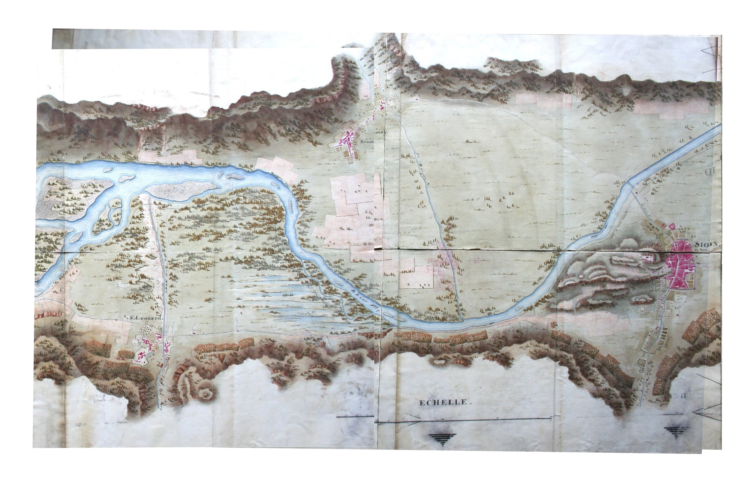
Plan de la Route de Genève à Milan by Le Simplon, 1802. Archives Nationales de France, Paris.
Diego Carnevale (University of Naples Federico II)
‘Water allocation systems and socio-economic hierarchies in a Mediterranean Metropolis (Naples, 1650-1700)’
The competition for resources has offered several examples of conflicts in different societies throughout human history. Historiography has investigated numerous aspects of the competition for water supplies, especially in rural areas, but neglecting cities. Since the 16th century, the ongoing population growth across Europe led to an increase in water needs. Rapidly, water became a field of confrontation between the powers that competed for controlling the city. In 17th century Paris «the king, the City, the merchants, and the citizens competed around the administration of the waters» , and so also in London.
The paper focuses on the case of Naples during the second half of the 17th century. Third city in Europe by population (the second one in the Mediterranean area), Naples was a megalopolis without a river, therefore, water supply required huge resources in terms of infrastructures and organization. By analysing allocation conflicts, the paper shows how different needs shape distribution hierarchies and which actors were most relevant in these processes.
Felicia Else (Gettysburg College)
‘Straightening the Arno: Artistic representations of water management in Medici Ducal and Granducal Florence’
Early Modern Florence could boast of its art and architectural beauty, but when it came to bodies of water, it was not always a pretty picture. Markers on its streets going back to the fourteenth century reminded the inhabitants of how dangerously high floodwaters could reach. Negotiating the urban and rural waters of the territory through river management featured as a key initiative of the Medici Dukes and Grandukes who wanted their efforts to be celebrated by court artists and humanists. In the visual arts, how to portray such feats had no clear iconographic traditions. The work of water management, be it repairing embankments or digging ditches, did not lend itself to the idealized, Michelangelesque style favoured by the Florentines.
This study will explore the strategies artists took in representing Ducal and Granducal authority over waterways, examining paintings, bronze medals and gilt reliefs celebrating the accomplishments of Cosimo I and his heirs. Among these are portrayals of the Medici with maps or reports, echoing material used by water management officials. Artists also developed idealized figures and symbols, such as the river god and a ferocious bull, a more obscure mythological reference. The lofty contexts of these artworks, from bold palace frescoes to intimate cabinets of precious treasures, contrasted dramatically with the laborious, even dangerous work of actual water management. Such works marked the legacies of water control that Medici promoted for their dynastic line, one that presented an image of generosity and benevolence that did not always match the reality.
Deborah Howard (University of Cambridge) and Simone Rauch (Ca’ Foscari University of Venice)
‘Acqua, Terra, Fuoco”: curating an exhibition on the proto-industrial architecture of the early modern Veneto’
The career of the celebrated architect Andrea Palladio was underpinned by a proto-industrial revolution. A research programme funded by the Leverhulme Trust allowed us to explore the surviving infrastructure of the Veneto’s manufacturing sector between around 1500 and 1650. The second half of the sixteenth century in particular saw a huge increase in applications to the Venetian government for patents for new kinds of machinery, and this burst of invention was reflected in the expansion of the manufacturing sector.
Hydraulic energy provided the key to the phenomenon. Although water-powered flour-mills had been commonplace since antiquity, the flowering of industrial enterprise in the Renaissance expanded to include textile manufacture (especially wool and silk), paper-making, sawmilling, ceramics, leather tanning and mining. Hydraulic energy could be applied to any of these technologies.
After a two-year period of fieldwork funded by the Leverhulme Trust, we published the book Proto-Industrial Architecture of the Veneto in the Age of Palladio (Rome 2021, also available in Italian). An exhibition called Acqua, Terra, Fuoco, based on this research, opened at the Palladio Museum in Vicenza on 12th November 2022 to celebrate the Museum’s tenth anniversary. Our talk will describe the planning of the display and the selection of exhibits.
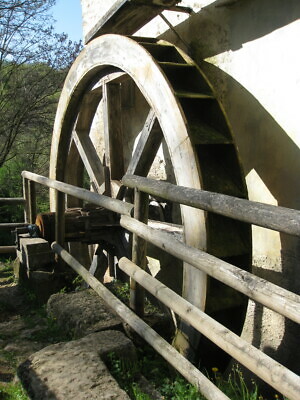
Water-wheel at Mossano (Vicenza)
Deniz Karakas (Independent Researcher)
‘Water, labour, and the hydraulics in seventeenth-century Istanbul’
Around 1614, the scholar Caʿfer Efendi (d. after 1633), while in the service of the chief architect Ṣedefkār Mehmed Agha in the capital city of the Ottoman Empire, Istanbul, wrote a treatise on architecture, Risāle-i miʿmāriyye. In the treatise’s dictionary, Caʿfer Efendi offers readers the definition of a topographical instrument, which was called terāzū in Turkish (mizān in Arabic) (Fig 1). One of his contemporaries, the Neapolitan fontaniere Giovanni Antonio Nigrone (active 1585–1609) provides a contemporary depiction that also explains the operation of this instrument (Fig. 2). Taking as its starting point the terāzū (balance), this paper will shed light on its seventeenth century users and explore the wide range of occupations, activities and realities of everyday practice behind the design, construction, and maintenance of Istanbul’s hydraulic infrastructure. This paper will also pay particular attention to the mobility of expertise. My specific interest is to offer additional contexts and connections for the study of how hydraulic knowledge and skills circulated during the long span of the early modern period, which I argue, can be located at the intersection between the relatively narrow scale of the local level and the much larger regional and trans-imperial connections across the Mediterranean.
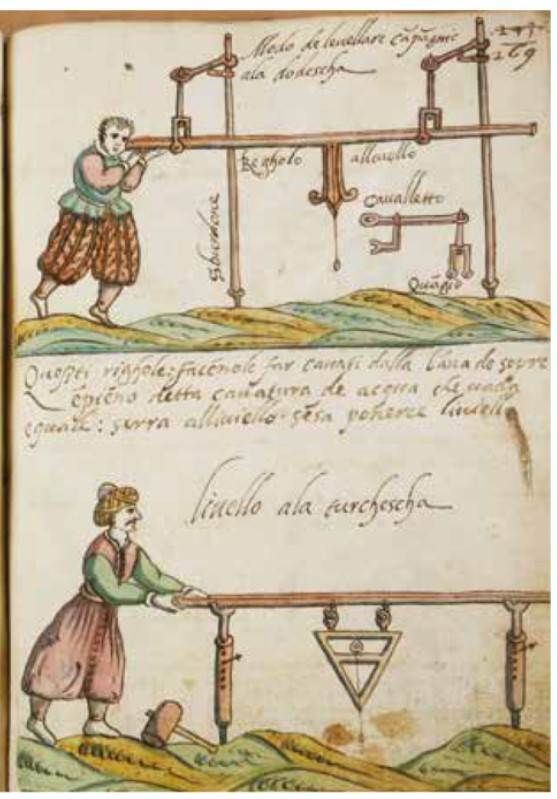
Giovanni Antonio Nigrone, Tools and techniques for leveling aqueducts from the “Vari discorsi di Giovanni Antonio Nigrone”, MS. XII.G.59, fol. 269r Pera Museum, Biblioteca Nazionale, Naples. On concession of the Ministry of Culture © Biblioteca Nazionale di Napoli.
Caroline Murphy (Villanova University)
‘Aquatic projectors and circulatory promises: the contested terrains of alluvial expertise’
In the mid-sixteenth century, Tuscany suffered an onslaught of severe alluvial floods. In an effort to mitigate this crisis, the ducal government of Florence implemented legislation to more strictly regulate rivers, and in 1549 founded a specialized bureaucracy, the Ufficiali dei Fiumi, to police waterways and engineer embankment defenses to protect urban and rural property. While the work of this administration (and analogous ones) represent the Tuscan state’s official response to alluvial disorder, the vexing problems of water would soon come to exercise a much wider array of technical and administrative experts, as well. From the final third of the century especially, these men, who I call aquatic projectors, began to advise on how rivers should be managed and ordered. In the orbit of the ducal bureaucracies and Court, and of diverse occupational backgrounds, they saw in the challenges of aquatic territory an opportunity to vie for ducal favor and patronage.
This paper will explore the rise of aquatic projectors, focusing in particular on the case of Lorenzo Albizi. By analyzing his proposal for recasting the waterways of the Pisan countryside, it traces a rising preoccupation with not merely containing flood damage, but also reimagining the utility of waterways as a vast circulatory infrastructure to facilitate traffic and commerce. In so doing, the study identifies an incipient way of thinking about aquatic territory as a space to be centrally planned for public benefit, while also demonstrating how aquatic projectors were active participants in an emerging political-economic discourse in early modern Italy.
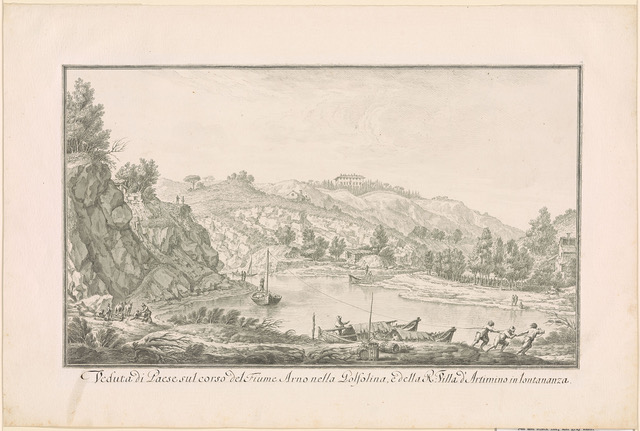
Veduta di paese sul corso del fiume Arno nella Golfolina, e della R. Villa d’Artimino in lontananza, by Giuseppe Zocchi (1744)
Marius Mutz (Universität Augsburg)
‘For they know not what they do. Flood, (in-)experience and the culture of managing stream works (Holy Roman Empire, c. 1550-1600)’
Looking at the construction sites of 16th century stream works in Central and Southern Germany, one might easily get the impression of a severe local lack of specialised knowledge in constructing earthworks resisting both artillery fire and the flood damage caused by nearby rivers. Unfortunately, these skills became crucial in an age of ever-intensifying gunpowder warfare and the increasing environmental effects of the Little Ice Age.
Hence, princely rulers of cities like the Bavarian fortress Ingolstadt and the Saxonian capital Dresden, which I will focus on in this paper, depended on experienced external specialists successfully transferring their elsewhere-gained knowledge to the respective building sites. Yet, though bringing in knowledge considered superior to the knowledge available locally, these specialists also had to deal with established administrative hierarchies and princely office bearers, which often delayed the construction progress. After all, the management of stream works was only one (terribly expensive) aspect of princely urban government which was not the main interest of many actors involved. The paper will analyse the communicative settings which were important for decision-making on building sites by comparing the cultures of managing stream works in the Duchy of Bavaria and Electoral Saxony, two of the most powerful states of 16th century Germany. It will argue that, even though circulation of experienced knowledge was crucial for the success of these building sites, the larger administrative structures must as well be considered. Also, I will present results of my PhD research on technical expertise in early modern Europe.
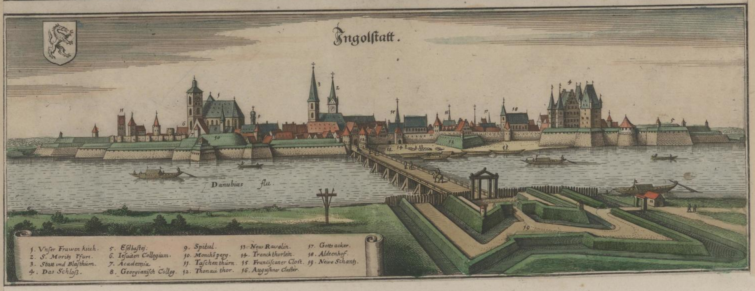
The Bavarian fortress at Ingolstadt seen from the south: 16th century waterworks and fortifications with minor 17th century additions (Matthäus Merian, 1644) (SLUB Dresden / Deutsche Fotothek)
Bob Pierik (Vrije Universiteit Amsterdam)
‘Hydrological practices and arrangements: Water access in Amsterdam as a social-natural site’
Urban water is an important social-natural site, which can be understood as a the nexus of human practices and material arrangements (Winiwarter and Schmid, 2020). In this paper, access to water in early modern Amsterdam will be considered as a socio-natural hybrid of environmental, social and cultural factors. This hybrid is also increasingly recognised as highly complex: European cities have had a considerable ‘water plurality,’ where different types of water systems co-existed (Janssens and Soens, 2019). Recent research on early modern Amsterdam has nuanced the view that the city was wholly dependent on clean river water imports and only relieved of its water problems with the introduction of piped water in the 19th century (Van Roosbroeck, 2019). We now know that the period of pre-piped water in Amsterdam was rather characterized by a mixed system of rain water harvesting and water imports for direct consumption, while even the ground water and surface water had their roles to play.
In this paper, I examine the interplay of everyday practices, technological infrastructures and urban governance to reconstruct the hydrological assemblage of early modern Amsterdam and its development throughout the 17th and 18th centuries. For this, I consider various sources such as notarial deeds on everyday urban conflict and encroachment tax registers (precariobelasting), to investigate how access to urban waters was facilitated and fought out ‘on the ground.’ These provide snapshots of everyday life in which using, owning or maintaining parts of water infrastructures feature prominently.
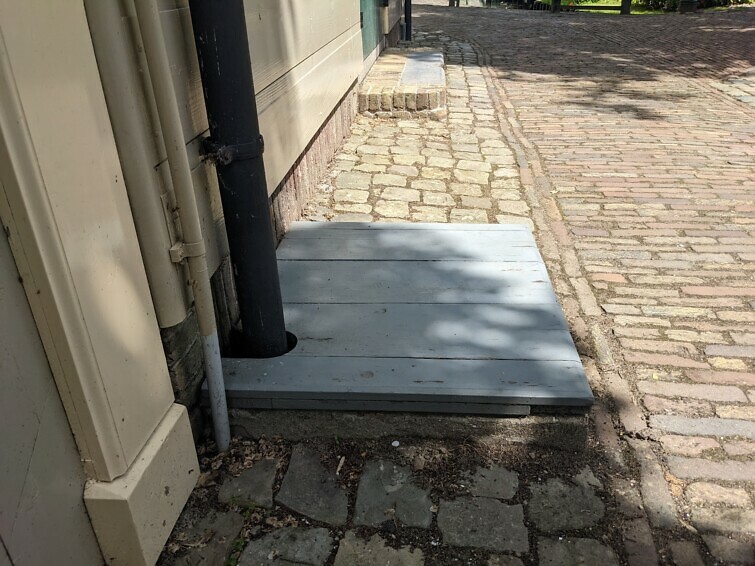
A street cistern in Amsterdam. Photo: author
Roundtable: Water across time and space
Contributors: John Henderson (Birkbeck College, London), Marina Inì (Cambridge University), Janna Coomans (Utrecht University) and Neha Krishana (Independent Scholar)
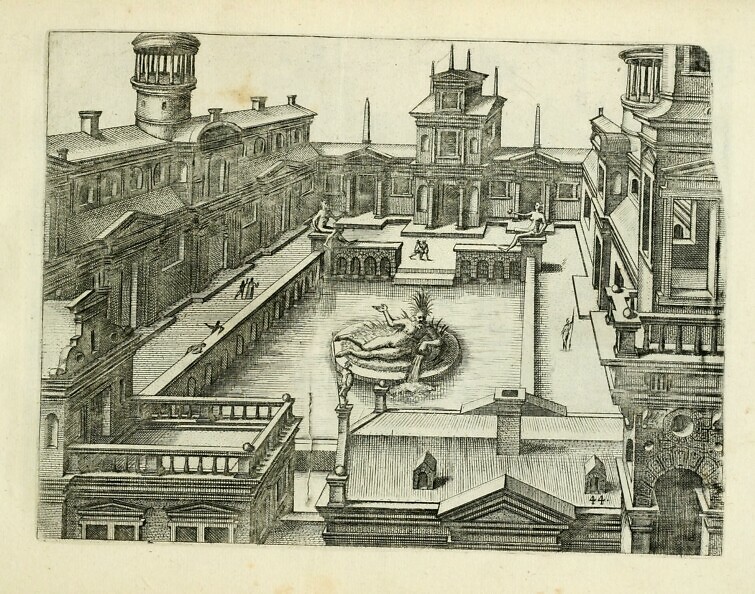
Imaginary cityscape with fountain by Hans Vredeman de Vries, published in Variae architecturae formae (Antwerp, 1636) (digitised by Getty Research Institute)
Convenors
Lavinia Maddaluno (Ca’ Foscari University of Venice)
Lavinia Maddaluno is a historian (Cambridge, History Faculty, PhD) and historian of science (Cambridge, HPS Department, MPhil). Her expertise is situated between the history of science and intellectual history, and her central research question concerns the role of scientific knowledge production in the realisation of ideas of wealth, state and society in early modern Europe. She has held fellowships at the British School at Rome, The Scaliger Institute (Leiden), the Università Federico II (Naples), and the EUI (Florence) and has been the first recipient of a joint Warburg/Villa I Tatti fellowship for the History of Science. She is currently a member of the “The Water Cultures of Italy, 1500-1900” project (Ca’ Foscari), directed by Professor David Gentilcore.
Davide Martino (University of Cambridge)
Davide Martino is a PhD candidate in History at St John’s College, University of Cambridge. His thesis, provisionally titled ‘Hydraulic philosophy in early modern European cities’, is supervised by Dr Richard Serjeantson. His PhD is generously funded by a Gates Cambridge Scholarship. Davide completed a History BA (2016) and an Early Modern History MPhil (2017) at Cambridge. Prior to starting the PhD he worked as a primary school teacher, and he remains passionate about the role of education in society.
Giacomo Savani (University of St Andrews)
Giacomo Savani is a Royal Society of Edinburgh Saltire Early Career Fellow at the School of Classics, University of St Andrews. He works mainly on Roman social and cultural history, ancient environments, and the reception of Antiquity in Early Modern Europe. He is particularly interested in ancient baths and balneology, focusing on their reception in Renaissance Italy and eighteenth-century England. He is currently writing a book for Routledge, Rural Baths in Roman Britain: A Colonisation of the Senses, forthcoming in 2023. Giacomo previously held fellowships at the University of Leicester and University College Dublin and collaborated with the Archaeology and Classics in the Community Project at the University of Leicester.
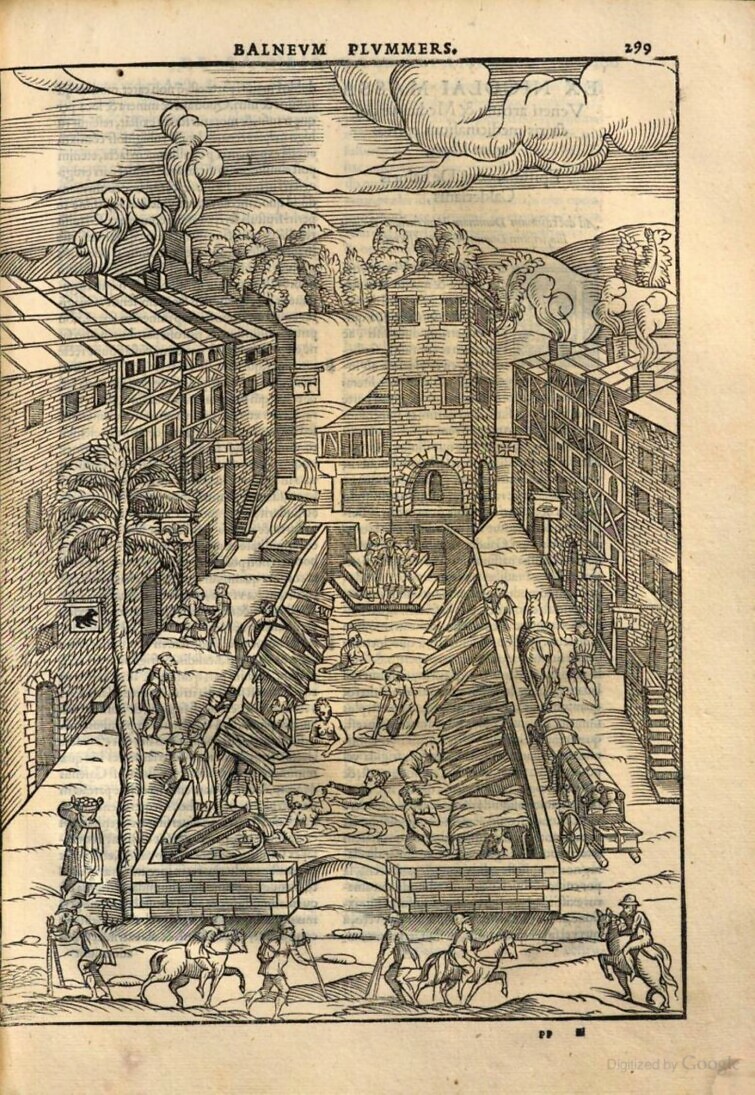
The baths of Plombières-les-Bains, woodcut from De Balneis omnia… (Venice, 1553) (digitised by European Libraries).



